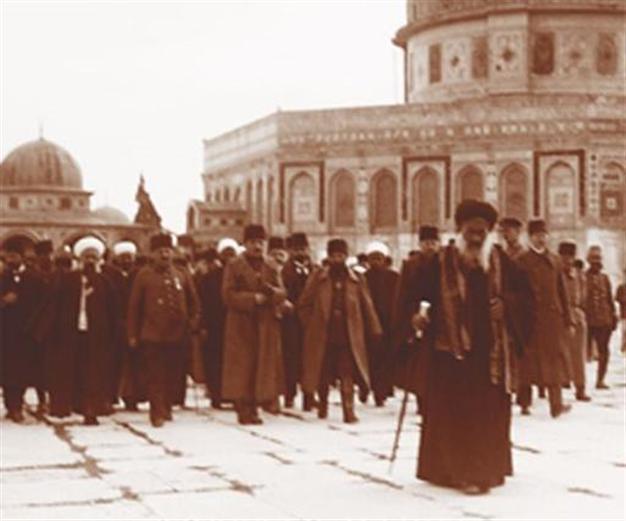‘Jerusalem: From the Ottomans to the British’ by Roberto Mazza
William Armstrong - william.armstrong@hdn.com.tr
 ‘Jerusalem: From the Ottomans to the British’ by Roberto Mazza (I.B. Tauris, 2013, £18, 288 pages)
‘Jerusalem: From the Ottomans to the British’ by Roberto Mazza (I.B. Tauris, 2013, £18, 288 pages)Jerusalem is a city almost entirely shaped by the imagination. Situated in hills without military or strategic value, and in possession of no key resources, the Holy City’s importance comes entirely from the stories invested in it. Roberto Mazza’s “Jerusalem…” is an academic account of the transitional period from Ottoman suzerainty to British conquest and rule – a time when the foundations of the modern city were laid and the origins of its present-day imbroglio planted their roots. For its length, it offers a reasonably comprehensive account of the events that took place and the relations between Jerusalem’s various communities. Still, considering that the subject is a place that – according to the three religions – is the gateway to the divine world, the dry academic approach taken by Mazza often feels rather zestless.
The book opens during the Ottoman Empire’s “Tanzimat” reforms of the 19th century. Cities were at the forefront of this reform process, and Jerusalem was one of the empire’s first local municipalities to be established in the 1860s. The municipality quickly became the most influential and relevant institution in Jerusalem – a microcosm of the wider drive towards centralization and modernization that was taking root across the Ottoman Empire. While this modernization was based on European models, it was also driven by competition with the ascendant European powers. What’s more, these powers all coveted Jerusalem, and each forged relations within the smorgasbord of communities on offer in the city to gain leverage and influence over the Ottoman authorities.
Meanwhile, Arab nationalism – marked by Muslim-Christian unity under both the Ottomans and (initially) the British – penetrated local consciousness in the years up to the Great War. The onerous wartime situation then gave Arabs even more reason to oppose Ottoman rule, and this is vividly conveyed by the primary sources quoted by Mazza. Personal diaries such as that of Ihsan Turjman (
reviewed here) give a good impression of how wartime privations, Jewish migration, and the Turkish nationalist policies of the Young Turk administration all estranged ordinary Arab Jerusalemites from Ottoman rule. Ultimately, when the British entered triumphantly in 1917, celebrations broke out across the city, but elation over the fact that war had ended could not last long. As Arab musician Wasif Jawhariyyeh noted:
I remember this day [of the British occupation] to have been a very happy one for the people. You could see them dancing for joy in the streets, congratulating each other on this happy occasion … We did not realize that this damned occupation would be a curse, not a blessing, for our dear homeland.
Jerusalem’s many constituencies invested their hopes that the city’s new rulers would advance for their own interests, but such optimism would prove misguided.
The book is most interesting when examining the years leading up to the British conquest in 1917 and the subsequent occupation. At the beginning of the war, the British didn’t consider the Eastern front to be of any value, but - as has been the case for time immemorial - the symbolic value of the city eventually meant it became the object of intense military scrutiny. David Lloyd George, that notoriously bullish supporter of the Eastern front, was elected prime minister in December 1916, and believed that a strong effort in Palestine and Mesopotamia would change the course of the war. Facing bloody stalemate in Europe, the new PM was looking for a personal victory and moral reward for Britain, and the capture of Jerusalem (on the third attempt) inspired a considerable amount of crude ideological manipulation. The Times described it as “the most memorable event in the history of Christendom,” and many others got excited about a new round of crusades, with British General Edmund Allenby cast in the role of a modern day Godfrey de Bouillon.
However, while the conquest was a winning bet in the short term, in the long run the occupation of Jerusalem only created more complex disputes. Indeed, British rule had less auspicious resemblances to the crusades than Lloyd George’s tub-thumpers recognized at first. When de Bouillon entered the 11th century city he immediately faced violent internal divisions among the Christians, and General Allenby also had to face rising tension among the different ethnic and religious communities of Jerusalem. Mazza’s book concludes with a detailed account of the inter-communal “Nebi Musa” riots of April 1920, during which nine were killed and several hundreds injured. The events are described as “the two emerging national movements … testing each other’s strength,” but they also set an unpleasant test for the British military administration. The riots indicated the impossibility of the British task at hand, and were a dark harbinger of the city’s future.
Notable recent release
‘The Archaeology of Jerusalem: From the Origins to the Ottomans’ by Katharina Galor and Hanswulf Bloedhorn
(Yale University Press, $40, 368 pages)
William Armstrong,
 ‘Jerusalem: From the Ottomans to the British’ by Roberto Mazza (I.B. Tauris, 2013, £18, 288 pages)
‘Jerusalem: From the Ottomans to the British’ by Roberto Mazza (I.B. Tauris, 2013, £18, 288 pages)